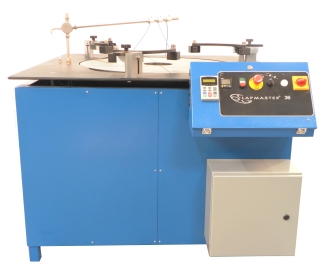Results 11 to 20 of 21
Thread: New (to me) Swatys
-
11-13-2014, 01:20 AM #11

Could be,,,, but instead of searching out granite inspection plates, I think I'll stick with a proven DMT,,,,,, that's if I lap a barber hone to begin with,,,,

-
11-13-2014, 01:29 AM #12

Mk 1 eyeball (before cleanup) said they were both straight level and flat. Proof will be in the pudding when I put steel to them. I usually get one shave after the barber's hone then the linen and latigo before the next shave.
OldTraf
Mind the toe, and the heel, 'twill follow.
-
11-13-2014, 01:34 AM #13

Old masochist here. The plates were made by using three of them and a certain order of lapping the surfaces was required to prevent dishing of doming.
Process developed by Whitworth (England) in the early 19th Century and still a final arbiter of flatness to this day.
Good read...for a machinist:
Surface plates.doc
Any side thrust will put pressure on the opposing side. And a figure 8 or similar motion is used while rotating the plate.
So not all old masochists have all the information. I was taught by a real old timer and can't do 1% of what he could.
~RichardBe yourself; everyone else is already taken.
- Oscar Wilde
-
The Following 3 Users Say Thank You to Geezer For This Useful Post:
Blistersteel (11-15-2014), Hirlau (11-13-2014), tintin (11-13-2014)
-
11-13-2014, 01:36 AM #14
 Be yourself; everyone else is already taken.
Be yourself; everyone else is already taken.
- Oscar Wilde
-
11-13-2014, 01:38 AM #15
-
-
11-13-2014, 01:45 AM #16

Assuming similar size, shape, hardness/abrasion resistance you can use three hones to lap each other.. Two stones will not necessarily work, especially if they are didissimilar hones.. As I understand it the three hone lapping method was used by Japanese woodworkers prior to diamond plates.. A laps B, B laps C, then C laps A. Continue this until all three stones are flat..
-
The Following User Says Thank You to ezpz For This Useful Post:
Geezer (11-13-2014)
-
11-13-2014, 02:25 AM #17

Two optical plates have been used since Egyptian Times for making lenses by off center pressure and rotation of the top plate..
History_of_optics
The lapping machines I am familiar with for flats are horizontal rotary plates of large diameter and oscillating and rotating flat plate holders.

~RichardBe yourself; everyone else is already taken.
- Oscar Wilde
-
11-13-2014, 07:49 AM #18Senior Member

- Join Date
- Sep 2013
- Location
- NW Indiana
- Posts
- 1,060
Thanked: 246
Yeah Richard has it straight. You need to use 3 plates if you want them to end up perfectly flat (or shall we say as near as possible, nothing will ever be perfectly flat). You lap A to B, B to C, then A to C, and keep going until they're flat. Using two plates will get you two plates that are mirror images of each other but not necessarily flat - and in almost every case they will be dished low in the middle on one and high in the middle on the other if you don't do your due diligence on spreading the wear properly and evenly.
-
The Following User Says Thank You to eKretz For This Useful Post:
OldTraf (11-13-2014)
-
11-13-2014, 03:33 PM #19
-
11-13-2014, 05:03 PM #20

Wonderful! The air is clear
With a Swaty, there really is only about 6 laps to resharpen the edge of a well honed razor and so they really do not need to be dead flat. A rolling x should be sufficient.
A perfectly straight cutting edge may need special care, though.
Wet Dry abrasive papers on a flat??!! surface is usually plenty for what we need to accomplish.
A second stone may be used to modify another. That is what we do when flattening our hones. If the hone to be flattened is smaller that the flattening stone and a figure eight motion is used the results are usually very good...for our purposes.
And, from my experiences with hones in from the wild, there were a lot of razors honed on badly dished stones and the former owners modified their strokes to have a sharp razor from what we would say is trash.
It is idiots like me that try for perfection and don't have wings who cause all the hype for this or that.
Above all have fun!
~RichardBe yourself; everyone else is already taken.
- Oscar Wilde
-


 13Likes
13Likes LinkBack URL
LinkBack URL About LinkBacks
About LinkBacks









 Reply With Quote
Reply With Quote




